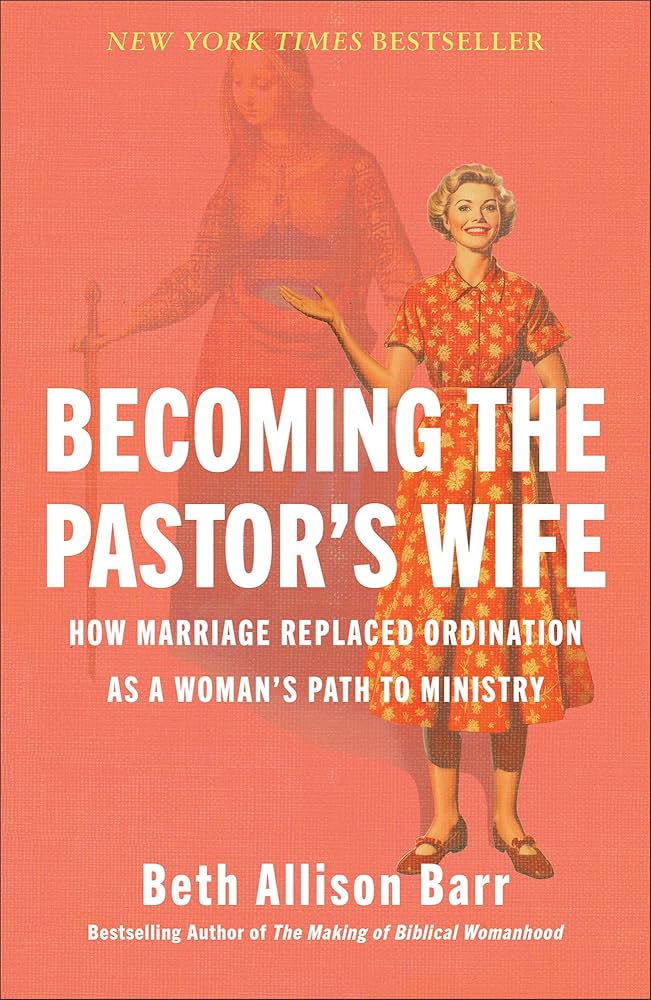Book Review: “Becoming the Pastor’s Wife: How Marriage Replaced Ordination as a Woman’s Path to Ministry”
By: Anne Kennedy

Editor’s Note: The following review appears in the Spring 2025 issue of Eikon.
Beth Allison Barr. Becoming the Pastor’s Wife: How Marriage Replaced Ordination as a Woman’s Path to Ministry. Grand Rapids, MI: Brazos Press, 2025.
“Oh, so you belong to the youth pastor?” Beth Allison Barr, James Vardaman Endowed Professor of History at Baylor University, remembers the first moment she discovered what it was going to be like to be a pastor’s wife. “I don’t belong to him,” she corrected the well-meaning church lady who was taking an interest in her life. “Oh, honey,” replied the lady with a knowing wink and a smile, “you belong to him.” Barr “stared at the woman.” She “knew” already that “a wife was often considered a participant in the pastoral job description,” and yet she found it “weird” and “unbiblical.” Moreover, she wonders if this cheerful and, one imagines, kind-hearted woman had “ogled” her fiancé. To be described as “belonging” to him felt, to her, like she would be “his property” (14).
If there is one pervasive theme running through Becoming The Pastor’s Wife: How Marriage Replaced Ordination as a Woman’s Path To Ministry, it would be the assumption that women should live and work independently of men. Dependence, for Barr, portends the abuse and subjugation of women (160). Despite her warnings, those within complementarian ecclesial spaces, the highwater mark of female dependency, continue to use “the Bible to justify privileging male authority.” They embrace “a patriarchal system born in white evangelicalism.” They “claim to support the spiritual equality of women and men even as they argue that God ordained a gender hierarchy and assigned a permanently subordinate role to women” (1–2).
But, the reader might ask, when were women ever “independent” from men, especially in the church? Barr undertakes to answer that question, sometimes in a most novel fashion. She focuses her research on the apparently “anomalous” role of the pastor’s wife. “Unlike other authoritative roles in church history,” she writes, “the role of pastor’s wife is not based on leadership skills, ecclesiastical office, or spiritual gifting. It is a role based on a human relationship — marriage. The calling of a husband assumes the calling of his wife” (xviii). This, for Barr, not only violates Holy Scripture but cuts against the historical practice of the church.
Barr believes that women must have been ordained to clerical roles in the early church. She finds evidence of single and married women in ministry (41). A married woman in the first and second centuries might “assume a significant spiritual function by assisting her husband in reforming the congregation by serving as a female moral model to the community” (42). Pricilla and Junia, for Barr, are incontrovertible examples of female “leadership” (10–11). Best of all, there is a peculiar second-century depiction of a woman in the catacombs of Rome with her hands held in the position of prayer usually associated with the Celebrant at the Eucharist, the “orans” position (35).
From the early church, Barr moves to the height of the Middle Ages to recount the life and times of Milburga, abbess of Wimnicas in the eighth century. “I’m a medieval historian who studies women and religion,” she explains, “I know that Milburga lived during a time when ordained women were more common and female leadership was not anomalous; a time when abbesses exercised pastoral and political authority over women and men, clergy and nonclergy” (29).
Eventually, as the medieval period drew to its inevitable demise, the Reformation supplanted the independent authority of women in the church by the invention of the pastor’s wife. “I want you to consider how the pastor’s wife role, even while becoming a respectable position for women in the church, could never be more than a mediated role,” she laments, “Beneath the license of a bishop and the trappings of a marriage ceremony, both the priest’s whore and the pastor’s wife are defined by their dependent relationship to a man.” The Reformation could have been a moment of unalloyed freedom for women. “There was no script for the wives of these early Protestant reformers apart from general expectations for godly wives. It’s important to remember that their husbands, formerly celibate clergy, probably had no idea what to expect from them either” (99–100). The moment was lost, however, and most clerical couples, scholars believe, fell into the “two for one” model that even now, she feels, plagues the church.
Barr leaps from the Reformation into the travails of the Southern Baptist Convention through the 1980s and 90s. She is particularly vexed by the prominent position afforded to women like Dorothy Patterson, wife of Paige Patterson and “first lady of Southeastern Seminary” (87). Mrs. Patterson, according to Barr, used all her resources and influence to destroy any possibility of women’s ordination being accepted by the wider denomination.
Throughout, Barr weaves in her own testimony of being a pastor’s wife. The pressure to “de-emphasize” her PhD work (50), questions about when she would have another baby (95), the humiliation of being asked to take the youth group girls to a different coffee shop (128), her personal experience is an intolerable burden of accumulated microaggressions. And she is not alone. Women, even today, find themselves putting together the bulletin, teaching Sunday School, and playing the piano for worship. The tasks undertaken by women married to pastors seem to have almost no limit. Except that, whenever she stands up to preach the sermon, the SBC passes yet another vote to prevent her.
It is not within the scope of this review to untangle Barr’s accumulated threads of historical evidence for the ordination of women over the past two thousand years (others will do that well enough). Her argument, however, is undone by a simple word that has no place in the kingdom of God. It is the word “independent.” Variations of it appear only 38 times in the 200 or so pages of the volume, but each time I encountered it, it felt like an acrylic nail across a Sunday School room chalkboard.
One such moment, for example, was her appeal to the Vestal Virgins of ancient Rome whom, according to scholars, were “legally isolated from their families so that they could function independently.” They “functioned as autonomous leaders who did not need the supervision of men” (18). That may be so, but their “legal isolation” from their own families was so that they could live lives of sacred service to Rome. Perhaps Milburga might be a better example. Her “story shows a time when women’s independent leadership in the church was more normative.” Barr relates that her ministry was “derived from her social status as an elite woman and from her ordination rather than from her dependent status as a wife” (55). Is this really the coup Barr intends? That a very rich woman with brilliant family connections inside a tightly woven ecclesiastical and social fabric used her influence to nurture a celibate monastic community and thereby build up the whole kingdom of God? Such an undertaking could only be successful within generational layers of dependence and belonging. I can’t help but wonder if Milburga would have thought of herself as “independent.” I’m not sure she would have even understood the word.
There is no such thing as “independent leadership” in the kingdom of God. Everyone is subject to the Head, Christ himself, in whom God arranges all the members of his body (1 Cor 12:12). Therefore, human relationships are not characterized by autonomy. The ear can’t say, “Because I am not an eye, I do not belong to the body” (1 Cor 12:16). A pastor not only relies on other elders and ministers — or in the case of my denomination, a bishop to whom he owes obedience — but he is bound to his own congregation with the bonds of love. They “belong” to him and he to them, in ways analogous to the way he is bound to his wife if he has one. If she does any work alongside him, she stands in a long line of women who poured themselves out in love, who were grateful to belong to their husbands and the congregations under their care.
